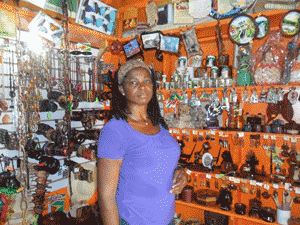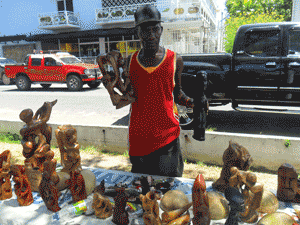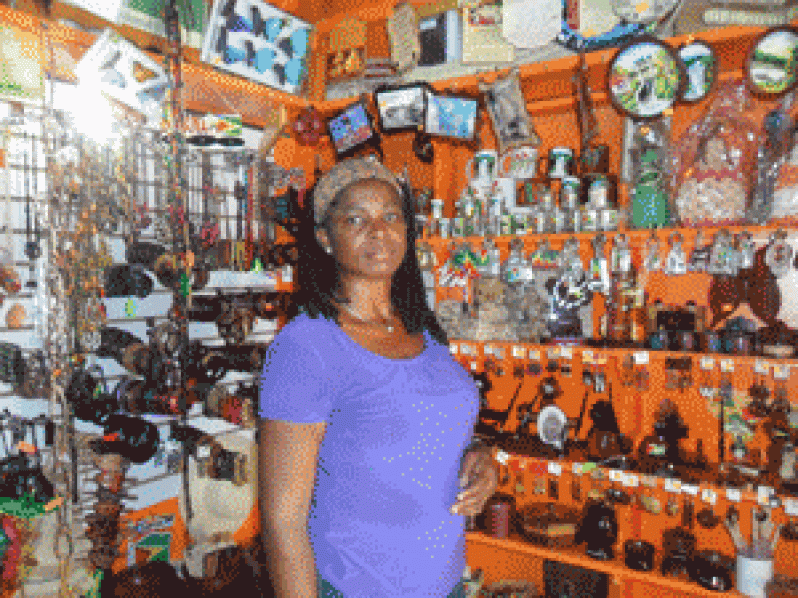THE cries of local craftsmen for help and intervention by government entities have, over several years, still not yielded the expected results.
 But those making the appeal hope to maintain their livelihood through the trade.
But those making the appeal hope to maintain their livelihood through the trade.
This Guyana Chronicle reporter met with several of the craft traders who operate on Main Street and a few in front of the General Post Office (GPO) building, also in Georgetown and they all had sad tales to tell.
All of them are trading in key rings, sculptures and other items made from local materials, including tibisiri straw, purpleheart wood, beads, sea shells, leather, and cassava starch.
The complaints around the mini Hibiscus Mall, in front of the GPO, was that sales have continued to be poor, save for when visitors and tourists come to Guyana. Some are of the view that, for them to see a boom in sales, the relevant authorities or government, in particular, will, first, have to provide monetary sponsorships or loans to assist them in properly marketing their products locally and internationally.
One complainant, Jacqueline King, who has been trading craft pieces for the past ten years, was forlorn as she talked about the challenges she has faced in the business.
Currency exchange
She said she has had to deal with the currency exchange rate, which throws a damper on her estimated sales because, when she quotes prices to overseas visitors, they would, usually, be aghast over the calculation in United States (U.S.) dollars.
King explained that, since visitors are accustomed to paying far less for such items in foreign countries, they disregard the exchange rate and would be reluctant to make purchases.
She also said many attempts at exporting to foreign markets failed because of shipping and clearance expenses.
Another setback for her is the weight restrictions on flights as she is required to take large amounts of her merchandise to ensure maximum sales abroad.
King also lamented the cost of airfares which put a dent and almost cripples her finances, at times. She concluded that, very often, she is unable to make a profit when she tries to access the foreign market.
She is adamant that she may be forced to stop the trade she has grown to love, which, at least, keeps her on her feet.
On Main Street were sculptures and other items on display with prices ranging from $4,000 upwards. But King said they could produce larger pieces that can cost up to $1.5M but those are extremely difficult to market.
The men on Main Street, too, had a tragic tale, including the revelation that they are mostly supported by students who embark on several academic projects that require purchases of many of their products.
Marvin Philips, who has been a tradesman in the field for more than a decade, said nothing has changed.
Special loans
“As a matter of fact, I come to work every day just wondering why the government can just focus on spending large sums of money on other projects and cannot even pause to acknowledge craftsmen, or even help them financially. I believe the government should make available special loans to help us promote and establish ourselves better.
“…. I mean this is a vibrant part of our Guyanese culture and it has received good reviews by many of our overseas visitors. Why is it that we can’t support our very own?” he asked.
Philips said his ultimate desire is to see the relevant authorities and corporate Guyana invest in the art forms and make their trade the celebrated forum it should be.
He feels that government should put aside finance in the form of loans or concessions for them to purchase raw materials for making the finished products.
Philips said a good strategy for local sales is to persuade the commercial banks and other entities to display their products in lobbies, waiting areas and offices.
Having specially sponsored exhibitions is also another way of promoting and marketing, he said.
Another craftsman, Leslie Hinds said the difficulties he encountered have been agonising but his love for the trade just keeps him pushing on.
He spoke angrily about what he said was the Government’s indifference.
All the time, it has been just lots of promises from the Culture Ministry but nothing good has happened so far, he complained.
He said, with proper government intervening, the trade can attain its maximum development and universal recognition and Guyana can be placed on the world map as producers of fine and excellent craft.
An official at the Culture Ministry mentioned that, not so long ago, efforts were made to relocate the open air traders to a secure location, but they had vehemently protested, saying they preferred to remain in Main Street for reasons of their own.



.jpg)









